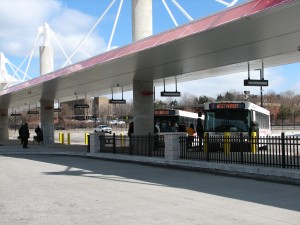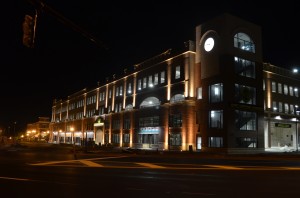On February 25, the NEOSCC Board will be voting on the the Vibrant NEO 2040 Vision, Framework and Action Products. Everyday over the next 5 weeks, we will be sharing an “Initiative A Day” so you can gain a better understanding of the vision and framework! If you would like to read all of the Initiatives, you can download them here Vibrant NEO Recommendation and Initiatives.
Show your support for Vibrant NEO 2040 by adding your name to our Champions of Vibrant NEO 2040 list here!
Recommendation 5: Enhance and coordinate the region’s rail and bus services

This kind of coordination happens at multiple scales: it involves regional route planning to coordinate and enhance services along important regional corridors, but it also involves inter-jurisdictional coordination of service schedules, stop locations, common information sources, one fare media for all providers, branding and marketing, and other more detailed factors of transit service to ensure that different transit agencies’ local systems work together to provide high-quality region-wide service. At its heart, though, this recommendation is intended to take advantage of the ongoing commitment of Northeast Ohio communities to public transit, find greater strength in this service through strategic coordination, and enhance the existing transit services to become more than the sum of their parts.
POLICY: Create a comprehensive regional transit plan that crosses county boundaries. Regional public transportation coordination focuses on maximizing the benefits of the public transportation investment through the coordination of services. Currently, there is no overall regional transit plan for Northeast Ohio.
TOOL: AMATS Public Transportation Needs Assessment: The Public Transportation Needs Assessment report identifies and describes the public transportation needs of the AMATS Area between 2010 and 2030. In the process of identifying the area’s transportation needs, several important AMATS transportation objectives were considered:
• System Preservation
• Basic Mobility for All Persons
• Cost-Effectiveness and Efficiency of Travel
• Coordination among the Area’s Transportation Providers
• Safety and Security
• Environmental Impacts
• Support for the Planning Objectives of the Area Communities
• Support of the region’s Economy
A transit needs assessment like the one employed by AMATS that expands beyond an MPO’s planning boundaries to encompass the needs and patterns for the entire region, especially as they relate to commuting, would be a good first step in identifying ways to improve accessibility and mobility. http://www.amatsplanning.org/
TOOL: ODOT Program Resource Guide:
TOOL: Unlocking MPO Funding Tools to Support Sustainability
Northeast Ohio should consider the following specific initiatives to achieve this:
Initiative 5.1: Invest in a regional network of bi-directional public transit connections between Northeast Ohio’s major job centers.

This initiative would maintain all transit operators’ primary missions of serving their local communities, while expanding the traditional service area boundaries to connect the region’s primary job centers. This initiative would allow transit to better respond to the region’s existing and emerging economic driver industries and extend the range of modal choice available to Northeast Ohio employees. It does not need to mean that each transit agency commits to offering extensive service outside of its core boundaries, but rather that a regional system of high-frequency express services becomes part of the regional transportation network.
WHY THIS IS IMPORTANT Economically strong and vibrant regions offer multiple transportation choices. In an era of growing travel demand but increasingly limited funds for transportation infrastructure expansion, transit service utilizing existing corridors and infrastructure becomes a key approach to offering transportation choice beyond local services in a way that is responsive to the needs of a regional economy. It also provides a basis for focusing land use and economic development policy on the region’s key employment and activity centers, as transit represents a public investment that must be managed to return the greatest possible value to the counties that support it.

GETTING IT DONE: This initiative will require leadership from transit operators, with support from NEOSCC and regional planning partners, particularly the region’s four MPOs, TeamNEO, and the Fund for Our Economic Future. NEOSCC and regional planning partners can pursue further study of the corridors highlighted in the Vision Map, leading corridor identification and analysis studies. With transit operators serving Northeast Ohio communities generally incorporated by county, however, it is advisable for the partnership to first explore and identify a range of suitable organizational structures for operating continuous service across jurisdictional boundaries in critical employment corridors. This will ensure that planning proceeds with sensitivity to institutional parameters.
A number of stakeholders must be involved in implementing a truly regional transit system that connects the region’s major job centers. Given the complexity of the task and the scale of the region’s geography, implementation should build on existing partnerships and begin with small, achievable steps. The region’s transit agencies meet regularly on operational issues and have participated in crafting the Vibrant NEO 2040 Recommendations and Initiatives through a “transit caucus” convened for that purpose. This caucus could collaborate on the implementation of these Recommendations and Initiatives. The MPOs have the capacity to bring together transit, business, and community interests within their jurisdictions: the Northeast Ohio Areawide Coordinating Agency’s Transit Council is a functioning partnership that could serve as a model platform for identifying and addressing the practical issues of creating the public/private and interagency partnerships that will be required to implement this recommendation.
Lead |
Transit Operators; Metropolitan Planning Organizations |
Target Community |
Strategic investment areas, asset risk areas |
Implementation Complexity |
High |
These recommendations, initiatives, and products, are not one-size-fits all and some aspects of the initiatives won’t be applicable everywhere in the 12-county region. The Vibrant NEO 2040 Vision, Framework and Products are intended inspire and guide decision-making at the Metropolitan Planning Organization (MPO), Council of Government, and local levels to ensure that land use, transportation, and environmental considerations are simultaneously addressed by their processes. Ultimately, the implementation of Vibrant NEO 2040 is up to Northeast Ohio’s communities and residents. But regardless of the applicability of each initiative to any particular part of the region, the goal for each community within the Vision is the same: stability, prosperity, and a high quality of life for all of its residents.
